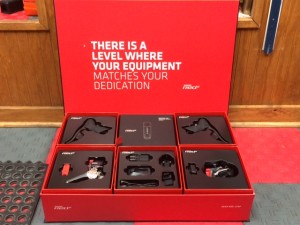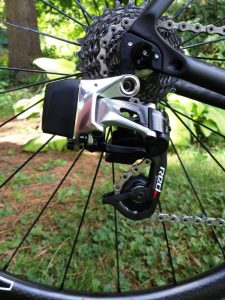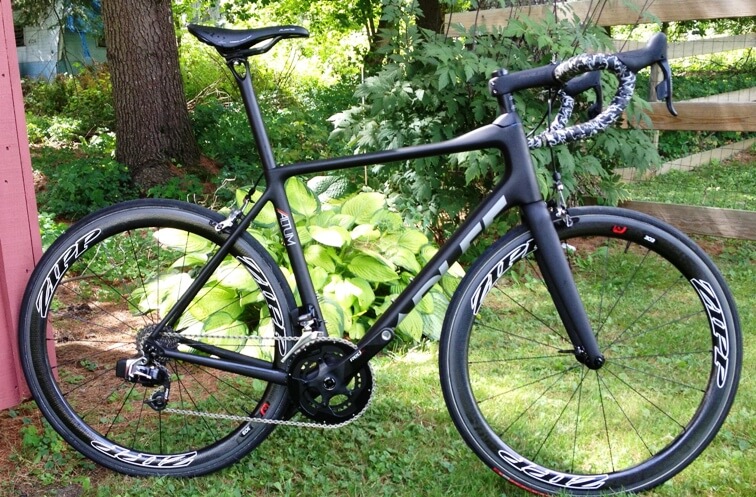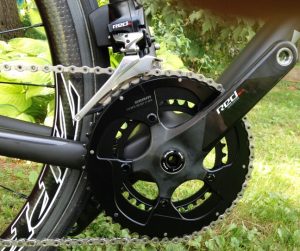SRAM Red eTap Wireless Electronic Shift System Review
 The SRAM Red eTap electronic shift system, while technically “available” since early ‘16, was in very short supply for much of the ’16 season and almost impossible to get. Thankfully, SRAM has now begun to produce this system in higher volumes, and availability has improved greatly. I have just finished building our two bikes equipped with SRAM Red eTap, a Moots Vamoots RSL and a Parlee Altum – both beautiful bikes – and wanted to share some of my impressions on the system.
The SRAM Red eTap electronic shift system, while technically “available” since early ‘16, was in very short supply for much of the ’16 season and almost impossible to get. Thankfully, SRAM has now begun to produce this system in higher volumes, and availability has improved greatly. I have just finished building our two bikes equipped with SRAM Red eTap, a Moots Vamoots RSL and a Parlee Altum – both beautiful bikes – and wanted to share some of my impressions on the system.
Many articles have appeared on-line about the SRAM Red eTap shifting system and there is very little that I can add to those exhaustive technical descriptions. Instead, I thought that I would focus on what I feel are the most salient features, and our riding impressions. For those that are not interested in a long read, I’m going to start with a list of the key benefits of the SRAM Red eTap system.
SRAM Red eTap Advantages
- Cleanliness of install – no wires. How a bike looks is an important consideration in every bike I build, and there is nothing that looks better than not having to worry about shift cables or wires.
- The ability to carry a spare battery, something that cannot be done with the other electronic systems.
- A full Red eTap system, including shifters, derailleurs, crank, chain, cassette, and brakes, is 150 grams lighter than a full Dura Ace Di2 system. For those seeking the lightest bike, that is a third of a pound – a significant amount. The SRAM Red eTap contributed to the pictured Parlee Altum weighing in at 13 pounds 7 ounces. Even if you carry a spare third battery, it is still a 125 gram weight advantage.
- Ease of assembly. I would much rather build a bike with eTap, as there are no cables to run inside the frame, nor a battery to somehow secure inside the seat post or seat tube. Cabling a Shimano or Campagnolo equipped bike can be a time consuming and sometimes very frustrating exercise. Fishing cables through a frame, particularly through a chain stay, is not easy even with tools like Park Tools IR-1 internal cable routing kit. There is no need for such things with eTap and that means that even the most complicated of aero TT frames is easy to set-up the shifting system.
- The sound of silence. SRAM Red eTap has no wires, there is nothing inside the bike frame to bounce around, making annoying noises, a problem that plagues some installations of both Shimano and Campy’s systems.
Now, for those who want to learn more, here you go…
SRAM Red eTap – Wireless!
If you follow the progression of bicycle electronic shift system, you already know that the SRAM Red eTap system is primarily distinguished from Shimano Di2 and Campagnolo EPS by virtue of the fact that SRAM Red eTap is wireless. The shifters communicate with derailleurs via SRAM’s proprietary and thoroughly tested wireless protocol. I have heard of tests with 40 or 50 bikes grouped together, all equipped with SRAM Red eTap, with no interference from one bike to another.
Obviously a benefit of wireless is that it makes for a very clean installation, as can be seen on the pictures of the Moots Vamoots RSL and Parlee Altum. No more “nests” of cables and junction boxes around the stem, no cables to get snagged or accidentally cut and no more worrying about pinching that rear derailleur cable when putting your bike in the trainer or when installing a rear wheel either.
SRAM Red eTap Shifting Action & Ergonomics
 The second big distinguishing feature of SRAM Red eTap from EPS and Di2 is the actual shifting action. Both Shimano and Campagnolo use electronic set-ups that more or less mimic the action of their mechanical shifters. SRAM Red eTap, on the other hand, marks a significant departure from traditional shifting patterns. The shift lever on the left side moves the rear derailleur inward, to an easier gear, while the right lever moves the rear derailleur outward to a harder gear. Like Shimano and Campagnolo, the rear derailleur will continue to shift gears until you release the lever (multi shift). Up front, press both levers simultaneously and the front derailleur will then shift to the other chainring, whether that be to the larger or smaller chainring. While this sounds odd, it is actually pretty straight forward when riding.
The second big distinguishing feature of SRAM Red eTap from EPS and Di2 is the actual shifting action. Both Shimano and Campagnolo use electronic set-ups that more or less mimic the action of their mechanical shifters. SRAM Red eTap, on the other hand, marks a significant departure from traditional shifting patterns. The shift lever on the left side moves the rear derailleur inward, to an easier gear, while the right lever moves the rear derailleur outward to a harder gear. Like Shimano and Campagnolo, the rear derailleur will continue to shift gears until you release the lever (multi shift). Up front, press both levers simultaneously and the front derailleur will then shift to the other chainring, whether that be to the larger or smaller chainring. While this sounds odd, it is actually pretty straight forward when riding.
When it comes to how the SRAM Red eTap system feels in your hand, I found it very similar to SRAM’s mechanical shifter. It sounds like this svelte feeling (and look) is preserved in the soon to be released SRAM Red eTap HRD with hydraulic disc brakes.
SRAM Red eTap Auxiliary Shifter “Blips”
When I said that the SRAM eTap system is wireless, that is not entirely accurate as there are separate remote shift buttons available, called “Blips”, that are placed pretty much anywhere on road handlebars or used in the ends of aero extensions and on the brake levers on a tri bike. SRAM eTap “Blips” are wired, and plug into the shift/brake lever assemblies or into their own junction box. So, depending on how you configure your bike, there may be some wires around the handlebars that can be discretely hidden under bar tape. However, even with “Blips”, there is still no wire running from the front of the bike into the frame to the derailleurs.
SRAM eTap Batteries
The derailleurs on SRAM Red eTap are each powered by their own identical rechargeable battery. The batteries will hold a charge for about 600 miles (1,000 kilometers), which is not as long as Shimano’s Di2 system, but still very respectable and functional. If you are riding and the rear battery dies, you can simply switch the front battery to the rear to get you home. Also, you can buy batteries separately for $40 as they are relatively small and weigh only 25 grams. Carrying a spare battery is not particularly feasible with either Shimano’s or Campagnolo’s batteries, both of which are bigger, heavier and, with the exception of the rare Shimano external battery, all but impossible to get at on the fly.
The SRAM Red eTap shift levers need power to transmit a signal to the derailleurs, and each is powered by one 2032 battery. These batteries are readily available, and are the type found in many bike computers, watches, etc. The shifter batteries need to be replaced every 1 to 2 years, depending on use. I recommend that these be replaced annually, when you have your (recommended) annual tune-up. 
SRAM Red eTap Performance
The big question is, “How does it all work when riding?”. It did take a few miles to get used to the shifting scheme as it is different from everything else. However, it was not a significant problem and really no more of a learning curve than adapting between the different mechanical shifters from the three brands (SRAM, Shimano and Campagnolo). Once I adapted to the shifting, SRAM Red eTap worked great. Some reviewers have said that they felt the rear shifting was a bit slower than on Shimano Di2 and SRAM acknowledges that it is slightly slower as they wanted to extend battery life. This being said, if the Red eTap shifting is slower, it was nothing that annoyed me or that I found a detriment. I’m not sure I would have noticed the difference had I not been looking for it. Shifting up and down the cassette was precise, and holding the shift lever shifted the chain across multiple cogs smoothly, albeit slightly slower than Shimano. My personal impression is that Campagnolo EPS is the speed champion for multi-shift, closely followed by Shimano Di2 and SRAM Red eTap in that order.
The highlight of all electronic shifting systems is the precision and response of the front derailleur, and the SRAM Red eTap is no exception. The front derailleur utilizes the “Yaw” design first developed for SRAM’s mechanical front derailleurs that is designed to eliminate the need for any derailleur “trim” to avoid chain rub on the derailleur inner or outer plate. So, unlike Shimano and Campagnolo electronic front derailleurs, the SRAM Red eTap derailleur does not adjust its position as you shift through the gears in the rear. Once I had adapted to the shifter functions, I found both the front and rear shifting to be impeccable, with very precise shifting front and rear.
SRAM Red eTap Nits to Pick?
Aside from a short period of adaption, do I see any drawbacks or have any complaints with SRAM Red eTap? A few minor things I would change, almost all of which relate to programability.
 I would prefer if the eTap’s left shift lever moved the derailleur outward and right shifter moved it inward (shifting the chain in the direction that I am pushing the shift lever). Why would I prefer this? I don’t know. My brain just seems to want it that way. It was easy enough to adapt, so this was hardly a problem, but I would have found the system more intuitive if it reacted a little different.
I would prefer if the eTap’s left shift lever moved the derailleur outward and right shifter moved it inward (shifting the chain in the direction that I am pushing the shift lever). Why would I prefer this? I don’t know. My brain just seems to want it that way. It was easy enough to adapt, so this was hardly a problem, but I would have found the system more intuitive if it reacted a little different.
On a related item, the shifting design prevents you from shifting both the front and rear derailleurs at exactly the same time. For example, shifting both at the same time comes in handy as you approach the bottom of a hill in the big ring. You can’t do both simultaneously with the SRAM Red eTap, but you can come darn close by shifting the front first and then the rear. It takes an additional several fractions of a second to shift this way, so I don’t see this as a big deal and it would not put me off considering the eTap system on a bike.
With Shimano and Campagnolo’s electronic systems you can program the levers to work as you desire. No such programming is available from SRAM at this time.
This all being said, outside of the initial installation, I have rarely found the programming feature to be needed with Campagnolo or Shimano. The Yaw front derailleur eliminates the need to adjust front derailleur movement (where I program the Shimano system the most). As for changing the shift lever functions, having built well over 100 (maybe over 200…) Shimano Di2 systems, I have changed the shifter functioning on exactly two client bikes. The fact that I can do this is cool, but I have found it is hardly ever needed. So, the lack of programmability is likely not going to be missed by most folks on SRAM’s eTap.
I did hear of one anecdotal problem concerning a derailleur battery that bounced out of place on rough roads. Maybe the retaining clip was not properly secured, I don’t know. Assuming this was indeed a true story, I believe it to be a one-off problem. This system, including battery security, has been tested very extensively by professional racing teams, including multiple races across the cobbled roads in northern France and Belgium, such as Paris-Roubaix, without issue.
My final nit isn’t really a nitpick as much as a desire for SRAM to introduce the full range of eTap groups sooner rather than later. I very much look forward to the SRAM Red eTap HRD version that will be available in the fall and that will allow use with hydraulic disc brakes and I really hope that a long cage “WiFli” version comes out soon to allow for a 11-32 cogset to be used with the system. The 11-28 max low cog option with the current system is not as low as many people in our area would like and makes the system less functional on multistrada/adventure road bikes even with HRD. We expect/hope that this will be an option soon as well.
SRAM Red eTap Comparative Price
SRAM has priced the Red eTap system aggressively; the price is more than Shimano’s Ultegra Di2 system, but a fair amount less than the Shimano Dura Ace Di2 system that it competes most directly. At ~$500 less than Dura Ace Di2, 150 grams less weight, and offering the simplicity of the wireless system we expect SRAM’s system to compete very well with the current established electronic shift options.
Which Electronic Shift System is Best?
Like many things in life, there are some really good options that all work a little different and thus which is best for you all depends. All three electronic shift systems, SRAM, Shimano and Campagnolo, function great, just differently. It comes down to ancillary issues, such as the way each shifts (Shimano has two levers on each brake hood, while Campagnolo uses a lever and a button); how the brake hoods fit your hands; whether you want the absolute fastest possible shifting or the lightest weight; and other matters of personal preference. For these reasons, I cannot say any one of these systems is better or worse than another overall. Sorry.
SRAM Red eTap Final Conclusions
I liked pretty much everything about the SRAM eTap system very much, from the shape of the brake hoods to the precise shifting. Of course eTap is a great choice for a new bike, but I particularly like its applicability to bikes that predate all of the internal wire routing capability now commonplace. My Parlee is such a bike, as is my wife’s Serotta, and there are many great riding bikes like this on the road. If you have considered upgrading your 5 or 6 year old bike’s components, but were writing off electronic shifting because of having to route wires externally, the SRAM Red eTap system is the perfect solution. I could very easily live with Red eTap installed on my Parlee, and I am seriously considering making the switch from Campagnolo mechanical shifting to eTap in the next year or so for this reason.
The introduction of SRAM Red eTap electronic shifting has increased the competition in this expanding area of the bike component market. Originally Shimano had a monopoly with Di2, then Campagnolo came on board with EPS. Since then, both have gone through more than one generation of components. Meanwhile, SRAM was waiting on the sidelines, perfecting their wireless system. To me, the wait was well worth it. There are now three very valid and functional electronic systems. Contact us for more information.

